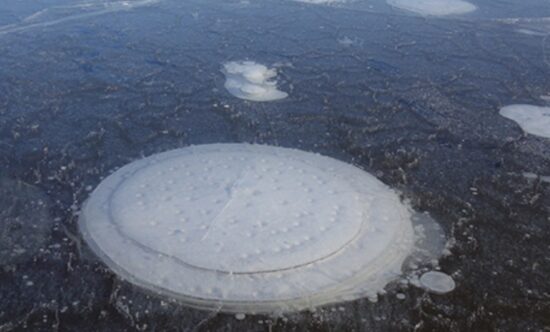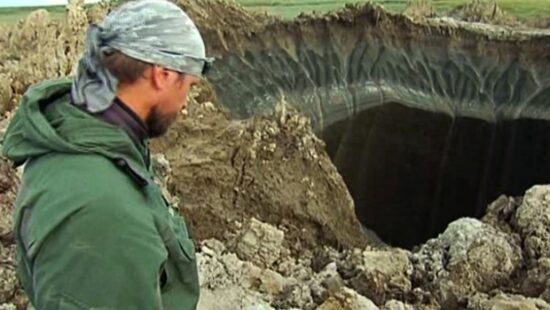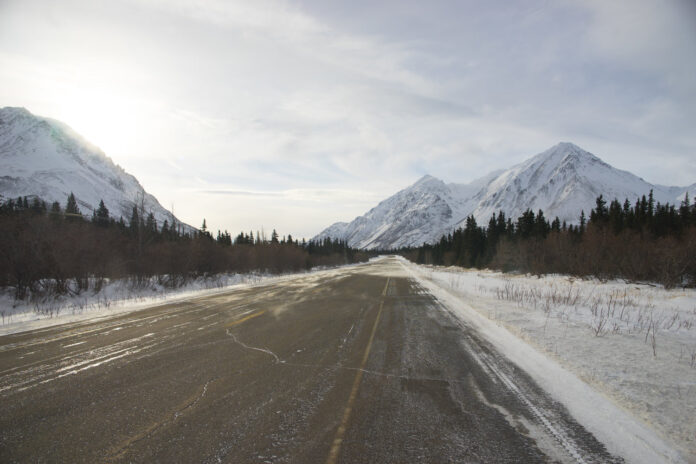In Part One of this two-part series on how atmospheric warming is contributing to the melting of permafrost, the permanently (not so much anymore) frozen ground found in Arctic climate zones, we looked at Canadian policy for dealing with the threat of methane (CH4) being released into the atmosphere and the consequential spike in global mean temperatures this would cause.
In Part Two we turn to other Arctic countries and their policies and plans for dealing with CH4 and permafrost.
Consider this. In 2019, the United Nations Environmental Program (UNEP) declared that melting permafrost was one of the top 10 emerging environmental threats to humanity and the planet.
The map featured at the top of Part One tells you why. Southern permafrost boundaries were seen to be moving poleward decade by decade over the 20th and into the 21st century. Projections for 2050 and 2070 showed just how much of the permafrost was likely to melt.
What this means for CH4 and the other released hazards from previously frozen soils as identified in Part One, is that our climate change narrative will change despite efforts to contain industrial-sourced CH4 and other greenhouse gas emissions.
A UNEP-supported rapid response study in 2020 that looked at Canada’s Western Arctic listed several steps to mitigate and adapt to permafrost melt. But so far, little has been achieved in Canada. And the question that arises, therefore, are other state actors in the same boat?
What follows is how other Arctic nations are addressing mitigating and adapting to permafrost loss and CH4 emission increases.
Alaska (United States)
Almost two-thirds of Alaska is underlain by permafrost. As the permafrost melts it is leading to an increase in the number of collapsed homes and roads across the state. Restrictions have been imposed on the use of heavy industrial equipment in permafrost zones, mainly those off-road. And although CH4 emissions are seen as a concern, there is talk of preserving the underlying carbon reservoirs that are the source of the gas, but no practical program or policies to address the challenge.
Both the state and the federal governments recognize more needs to be done but there is nothing in the carbon sequestration and capture provision of the recently passed Inflation Reduction Act to direct funds to permafrost CH4 mitigation.
NASA has been funding a University of Alaska Fairbanks (UAF) ten-year research study looking at arctic vulnerability. Called the Arctic-Boreal Vulnerability Experiment or ABoVE, it studies CH4 release from thawing permafrost with bubbles like the ones seen in the image forming under the surface ice of thermokarst lakes that characterize much of Alaska’s surface terrain.

Katey Walter Anthony, a lead researcher of the NASA study states, “The mechanism of abrupt thaw…matters a lot for the permafrost-carbon feedback this century. We don’t have to wait 200 or 300 years to get these large releases of permafrost carbon. Within my lifetime, and my children’s lifetime, it should be ramping up. It’s already happening but it’s not happening at a really fast rate right now, but within a few decades, it should peak.”
What happens if the thawing becomes abrupt? It is estimated that CH4 release rates will increase by as much as 125 to 190% compared to what would happen in a gradual melt. The soil layers where the carbon is stored are as deep as 80 metres (260 feet). The sudden thawing causes kettle and thermokarst lakes that cover the Alaskan landscape to suddenly drain producing a feedback loop that causes even more CH4 to be released, which in turn leads to atmospheric temperature spikes which contribute to even more thaw. For the IPCC, in its attempts to develop a CH4 carbon budget to cap and reduce these potent greenhouse gas emissions, the scenario poses a nightmare.
Denmark (Greenland)
Greenland is Denmark’s autonomous dependency. It is uncertain whether permafrost melt is a greater threat to the island than the collapse of its glacial ice sheet. Greenlanders don’t live on the ice sheets. They live where the melting permafrost is shifting the ground beneath their feet. They face the same problems that Alaska and Canada are experiencing with roads, bridges, homes and buildings all built on frozen ground that is turning to mush. The results are Greenland faces significant barriers to long-term habitability with CH4 emissions probably the least of its concerns.
Recent studies point to the destabilization of Greenland’s ice sheet which covers more than 90% of the island. All indicators point to substantial increases in melting throughout this century inevitably increasing global sea levels. The permafrost leaking of CH4 and other greenhouse gasses is, therefore, a lower priority with little appearing in Danish or Greenlander policy planning.
Finland
In 2021 the Finnish government published its Arctic strategy, a document outlining its policies on climate change mitigation and adaptation, the well-being of its northern indigenous people, research initiatives, and the hardening of existing infrastructure and logistics.
As one of the eight founding member states of the Arctic Council, one would think that Finland’s Arctic strategy would include a section focused on dealing with permafrost greenhouse gas emissions. But there is only a brief mention of this area of concern. How brief? Permafrost is mentioned four times in the 73-page policy document. Greenhouse gas emissions are referenced six times. Methane is never mentioned and there is a single paragraph talking about “concrete measures” to reduce emissions and a reference to “low-emission technological solutions.” What those technological solutions are is never spelled out.
So like Canada and the United States in Alaska, it would seem that Finland doesn’t have a handle or solution for permafrost melt and CH4 emission leaks.
Norway and Iceland
In these two oceanside countries permafrost makes up only 8% of the landmass without including Norway’s Svalbard Archipelago. So CH4 emissions don’t get much play in their policy statements. But where the thawing permafrost presents a problem for Norway is on Svalbard with Spitsbergen the largest island in the group the focus. And a second CH4 problem lies off Norway’s continental shelf where frozen methane hydrates can be found on the seafloor near its coasts.
Svalbard lies well to the north of continental Norway and is east of Greenland. It is experiencing a faster rate of warming than almost anywhere else on the planet. Winter temperatures have risen 3 Celsius (5.4 Fahrenheit) in the last few decades. The winter ice pack is shrinking by 10% per decade with summer ice loss even greater. By the end of the century, winter temperatures are expected to rise by 10 Celsius (18 Fahrenheit) over current levels.
Needless to say, Svalbard’s 2,300 residents are facing a permafrost melt challenge as is another important project that has its home on Spitsbergen. This is the Svalbard Global Seed Vault, a long-term storage bank for seeds that have been collected from around the world and are meant to be the last hope for humanity’s future in the event of a global catastrophe. The seed vault lies inside a frozen mountain where temperatures are kept at a constant -18 Celsius (-0.4 Fahrenheit) by the permafrost. In recent years artificial cooling systems have been introduced as Spitsbergen’s temperatures rise.
Methane hydrates are giant ice cubes containing CH4. They form when seeps of CH4 gas make contact with cold water in high-pressure conditions on the ocean floor. Methane hydrates remain stable only when climate conditions are constant. But that’s not the case off Norway’s coast where the Atlantic Ocean is heating not just at the surface but through its entire water column. That means several CH4 eruptions are likely to occur in the coming decades.
The consequences of ignoring methane hydrates are best demonstrated by the Gulf of Mexico Deepwater Horizon accident which occurred in 2010. It is believed that the presence of methane hydrates near the site may have contributed to the initial underwater blowout and the eventual fire that destroyed the rig killing 11 and injuring 17.
So Norway needs to address both Svalbard and methane hydrate in its CH4 strategic plan.
Russia
Russia’s CH4 and permafrost climate policies and strategies are not well known but they should be because 60% of the permafrost zone on our planet lies within its borders.
Siberian Russia is seeing permafrost melts that have caused some strange phenomena. In one case, a 30-meter wide (approximately 100 feet in diameter) hole opened up in July 2014 in Siberia’s Yamal Peninsula. The cause of the hole was CH4. The permafrost 20 metres (66 feet) below the surface saw temperature rises of 2 Celsius (3.8 Fahrenheit) when atmospheric temperatures on the peninsula were rising by 5 Celsius (9 Fahrenheit). The Earth belched and the hole seen below opened up.

A 2020 study by geologists from the University of Bonn measured CH4 levels in another area of Siberia where there were significant signs of permafrost melt. Gas concentrations were significantly higher than the norm. In this part of Siberia, atmospheric temperatures over a two-decade period had risen 6 Celsius (10.8 Fahrenheit). The geologists reported their findings in an article entitled Methane release from carbonate rock formations in the Siberian permafrost area during and after the 2020 heat wave which appeared in PNAS.
Along with released CH4, Siberia continues to unearth flora and fauna frozen for tens of thousands of years. Whole Mammoths have been unearthed. So have bacteria and viruses that have lain dormant over the same amount of time. These emerging microbes represent a growing health risk.
Whether the CH4 release is slow and steady, or punctuated and abrupt, Russia needs to get a handle on the level of permafrost melt happening within its borders. So far, there haven’t been enough studies done to get a fuller picture of the CH4 problem in that country, and the Ukraine war will not produce any current and future haste in collecting the much-needed data.
Sweden
Of the total permafrost areas in Scandinavia consisting of Finland, Norway and Sweden, the latter’s share of what amounts to about 23,400 square kilometres (just over 9,000 square miles), is only 35%. When the country enacted its 2017 climate strategy, it set a target to lower greenhouse gas emissions by 85% from 1990 levels and to be in negative emissions territory by 2045. But nowhere in the plan is there a mention of getting permafrost greenhouse gas emissions under control.
I guess this shouldn’t be a surprise after reading how all the other Arctic countries are managing to largely ignore CH4 leaks from melting permafrost.
What To Do
Short of dramatically reducing our use of fossil fuels in all aspects of the global economy, there seems little at present that we can do to tackle CH4 seeping from melting permafrost.
One initiative, however, can be done. We need to get a better measure of the problem. That could help determine the pace by which we do rapid reductions of greenhouse emissions where we have the means to control the process.
We are fortunate in one respect because CH4 doesn’t hang around in the atmosphere for very long when compared to CO2, the bigger greenhouse gas contributor. CH4, unfortunately, does impact warming in the short term at a rate 80 times greater than CO2 when it is hanging around.
Another unanswered question is just how big could the permafrost melt problem become. Estimates of CH4 volumes embedded in permafrost that could thaw this century are as high as a Gigaton. That’s a billion tons released into the atmosphere.
Can we stop it from happening?
Could refreezing the permafrost using technology keep CH4 in the ground?
The Willow Project is an oil field in Alaska owned by ConocoPhillips. The company has proposed that it could use chillers inserted into the permafrost to keep it frozen. This would be counted as a carbon offset for emission contributions made by the company’s operations.
Is this doable?
Could it be deployed wherever there is permafrost?









